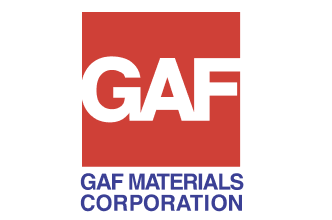General Aniline and Film Corporation (GAF)
GAF Corporation made construction products with asbestos from the 1920s until the 1980s. Asbestos lawsuits led the company to bankruptcy. It then had to set up a trust fund with $770 million for future claims.

GAF’s Connection to Asbestos
GAF’s connection to asbestos and involvement in mesothelioma claims traces back to its purchase of Ruberoid Company in the 1960s. The acquisition included an array of asbestos products and an asbestos mine in Vermont.
GAF’s roofing materials, like felts, had 60% chrysotile asbestos, as shown in legal documents. Paints used as coatings on roofs contained 10% to 20% chrysotile asbestos. At the time, companies used asbestos for its resistance to heat and corrosion.
GAF’s Asbestos Products
- Asbestos cement roofing shingles
- Airtred sheet vinyl flooring
- Boiler jackets
- Calsilite pipe covering and block insulation
- Coverkote
- Roofing felts
- Roofing paint products
- Ruberoid Air Cell
- Supercell pipe covering
- Vermont asbestos 7M insulating cement
The health issues the asbestos mine caused came into the public eye in 1973. A study found it would take $1 million to upgrade the mining operations for safety.
By 1975, GAF ceased operations at the mine. That year, mine workers raised $2 million to buy the mine from GAF and named their business Vermont Asbestos Group. Asbestos continued to be mined at the site until 1993.
Who Was at Risk of Asbestos Exposure from GAF?
Asbestos exposure was highest among miners at GAF’s Vermont mine. They developed diseases like mesothelioma, lung cancer and asbestosis. Employees at GAF’s and Ruberoid’s manufacturing facilities faced high levels of asbestos as well. Workers who installed or removed GAF’s asbestos products were also exposed.
GAF’s asbestos products were used in a variety of industries. The U.S. Navy used various GAF products. These include Calsilite block insulation and pipe covering, made for marine use. Oil refineries and factories used Imperial insulation, made to handle high temperatures.
Workers at Higher Risk
- Construction workers
- Boiler workers
- GAF asbestos miners
- GAF and Ruberoid manufacturing plant workers
- Flooring workers
- Insulators
- Metal workers
- Oil refinery workers
- Roofers
- Veterans of the U.S. armed forces
Workers in many industries used GAF Corporation’s asbestos products. This is especially true for those in roofing and siding. Construction workers are among the most at risk of exposure to these products. Family members of workers exposed to GAF products faced secondary exposure.
Remediation of old GAF properties and facilities can present an exposure risk today. In 2024, old GAF buildings required remediation before a residential development project could begin.

Access mesothelioma compensation through trust funds, settlements or travel grants.
Get Financial Help NowAsbestos Litigation Involving GAF
More than 70,000 asbestos lawsuits had been filed against GAF by the year 2000. Sick workers filed personal injury lawsuits, and surviving families filed wrongful death lawsuits.
These lawsuits claim product liability. They focus on negligent exposure and failure to warn about the dangers of asbestos. By 2001, GAF had settled more than 500,000 claims costing the company approximately $1.5 billion.
GAF Mesothelioma Settlements & Verdicts
- $155,443: The Superior Court of Pennsylvania ordered GAF to pay its part of a settlement in 4 combined cases in 2000. The Center for Claims Resolution negotiated the settlement. GAF argued it was CCR, not GAF, who entered into the settlement agreement with the plaintiffs. The superior court disagreed and ordered GAF to pay its share.
- $50,000: A judge in Connecticut ordered GAF to pay more than $50,000 to two plaintiffs in 2000. This payment was part of a settlement deal the Center for Claims Resolution worked out for GAF.
GAF was one of the major asbestos companies dealing with mesothelioma claims in the mid-1980s. So, they helped create the Asbestos Claims Facility. It was set up to evaluate, settle and defend claims about asbestos exposure. The claims facility fell apart over fights between the member companies and insurers.
An undisclosed settlement between GAF and 8,500 Maryland workers was reached in 1993. They sued the company claiming they got sick from working with GAF’s products. Most of the workers were exposed to GAF’s products at Bethlehem Steel Corporation’s Sparrows Point steel mill.
GAF Asbestos Trust Funds
G-I Holdings filed for Chapter 11 bankruptcy protection on January 5, 2001. As part of its reorganization, the company set up an asbestos trust fund. The trust was initially funded with $770 million. As of 2022, (the most recent year data is available), reportedly more than $298 million remained in the trust.
This bankruptcy action was taken because of the company’s liability from asbestos claims. It emerged from bankruptcy on Nov. 12, 2009. GAF was the 27th company in the U.S. to file Chapter 11 over asbestos claims. GAF employees who develop asbestos-related diseases are eligible to file a claim with the trust fund.
The G-I Holdings Inc. Asbestos Personal Injury Settlement Trust’s current payment percentage is 5%. The trust’s scheduled value of cancer claims ranges from $45,000 to $155,000. The payment percentage impacts the average payout range. The current payout range is $2,250 for lung cancer claims and $7,750 for mesothelioma claims.
Legal Help for People Exposed to GAF’s Asbestos Products
If you or a loved one developed mesothelioma from GAF products containing asbestos, you have legal options. You may qualify to file a GAF trust fund claim to seek compensation. These funds help pay for medical bills and make up for lost income.
You’ll want to file a claim before a deadline called the statute of limitations. This is a time limit on how long you have to take legal action. This period varies depending on where you live.
Our Patient Advocates can help you understand your legal options. They can explain the legal process clearly and connect you with the best lawyers for your case. Our Patient Advocate team can find the right law firm to help you make informed decisions about your legal future.
Recommended Reading


